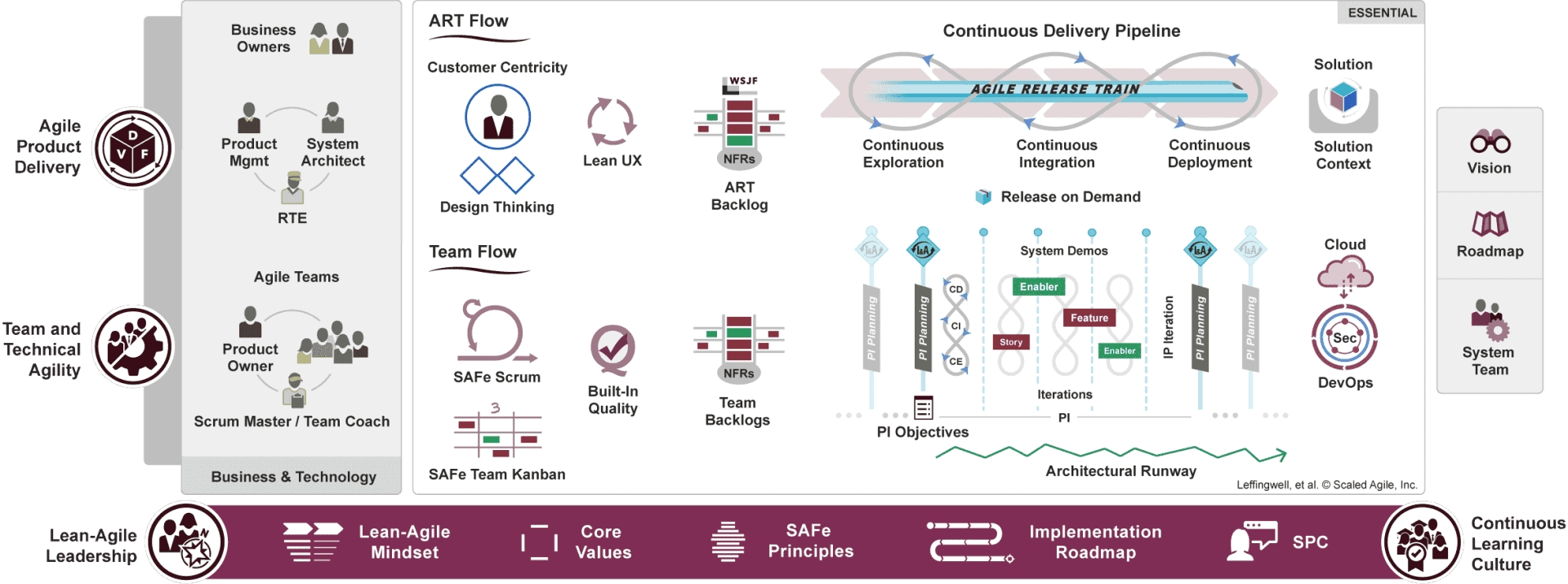
Software development methodologies: types, selection criteria & stats
April 16, 2024
- Home
- Software development
- Software development methodologies

by Vlad Nikitin,
Chief Technical Officer
Each methodology offers a unique approach to managing the software development life cycle, defining project steps, roles, responsibilities, activities, communication standards, and deliverables. The diversity in methodologies allows companies to choose the one that better aligns with their specific needs and project requirements.
To find the most appropriate approach for their case, businesses must factor in various criteria, as well as the pros and cons of each methodology. Seeking guidance from expert advisors who are well aware of the strengths and weaknesses of each methodology is yet another option that can help organizations set up a smooth software development process. With 25+ years in software development services, we use our solid expertise and industry best practices to help you decide on the optimal approach for your development initiative.

Current trends in software development methodologies
Since its inception in 2001 when the Agile Manifesto was created, Agile has been gaining traction because of its responsiveness to constant change and continuous delivery of value to customers. According to Digital.ai's 17th State of Agile Report, 71% of companies use Agile in their software development lifecycle.
However, some industries still use sequential methodologies that provide a predictable and structured approach with thorough preliminary planning in contexts where the risks and costs associated with uncertainty and rework are unacceptable, or an iterative roll-out is impossible or impractical due to the dependencies on physical infrastructure. At the same time, technological advancements like AI-driven data simulation and digital twins that emulate a software’s operational environment and enable its partial operability make it possible to apply Agile frameworks in sectors that earlier have heavily relied on sequential approaches.

Sequential methodologies
Sequential or plan-driven methodologies break up the software development cycle into consecutive, standalone phases. These models prioritize gathering detailed project requirements, planning the entire development process, and establishing deliverables for each phase before starting the development.
1
Initiation
2
Analysis & design
3
Planning
4
Implementation
5
Delivery
6
Support & maintenance
Scheme title: Project phases in a sequential software delivery model
Advantages and limitations of sequential methodologies
Advantages
- A straightforward, easy-to-understand workflow simplifies project management
- The sequential model facilitates project stages tracking for project sponsors
- Stable project requirements allow developers to better focus on the project’s goals and allocate their efforts more efficiently
- Clear project scope and predictable timeline, cost, and deliverables as a result of thorough project planning and early definition of requirements
- Detailed documentation makes tracking the project’s progress easier and simplifies software maintenance and further modernization
Limitations
- Extensive requirements gathering leads to a prolonged discovery phase
- Business stakeholders are mainly involved at the beginning of the project, which can result in lower end-user satisfaction with the finished software after the launch
- The inflexible step-by-step process contributes to lengthy project duration
- Addressing evolving requirements is challenging since it entails going back to the initial stage of development and re-elaborating requirements
Types of sequential methodologies
Waterfall
The waterfall development methodology follows a linear workflow, progressing from top to bottom through several stages that focus on distinct goals. Once the development process starts, no extensions or alterations to the project scope are allowed, so all requirements must be elicited during the planning stage. Developers must complete each stage before moving to the next one, meaning the software is implemented as the finished product at the end of the project.
Suitable for:
- Projects with well-defined, unchanging requirements and objectives
- Projects where timeline and budget control is critical
Scheme title: Waterfall development model
V-model
The V-model is an extension of the Waterfall methodology that emphasizes testing in parallel with the development process. Each subsequent development phase can only start after testing for the previous stage, thus reducing the probability of defects and errors in the final product and ensuring high software quality. However, the focus on the testing activities can make the development time-consuming and costly.
Suitable for:
- Projects that can use Waterfall but demand higher levels of quality and reliability
Scheme title: Software development life cycle in the V-model
Rapid application development
RAD promotes short development cycles and rapid delivery of functional software. This model focuses on iterative development, where the project is broken down into smaller modules developed in parallel by different teams. The RAD model implies gathering requirements through focus groups, prototyping and early user testing to get customer feedback and accommodate possible requirement changes before the development starts. It also emphasizes reusing software components across the system, adhering to strict upfront dependencies planning and precise project scheduling and coordinating, extensive requirements elaboration and software design efforts, as well as a team of highly experienced analysts and architects.
Suitable for:
- Projects where requirements can be identified upfront
- Systems that can be modularized
Scheme title: Process model for Rapid application development
Spiral
The spiral model combines elements of sequential and iterative approaches, which makes modifying requirements easier than in the classic Waterfall model. The development team works on the four software development stages in cycles, or spirals, and improves the product each time. Each cycle can take up to several months and starts with identifying project goals and planning, followed by risk analysis and management, which reduces the likelihood of errors and issues. Then, programmers build software based on the requirements gathered during the previous iteration. The software is evaluated at the end of each cycle to ascertain its alignment with the defined requirements. The project stakeholders then decide whether to proceed to the next iteration or complete the project, thus predicting the number of iterations required to finish the project with the spiral model can be challenging, which leads to uncertainty in the project timeline and cost.
Suitable for:
- Complex and large projects characterized by uncertainty or changing requirements
- Projects where risk management is critical
Scheme title: Software development life cycle in the Spiral model
Incremental
The incremental model breaks the development process into smaller, stand-alone parts, called increments. Each iteration can last up to several months, during which the team builds a particular feature set – a portion of the complete system’s functionality. End-users get access to a fully functional software subset with the implementation of the first increment while the development of further increments continues until the entire product is completed. With incremental development, potential issues can be detected early in the development process, minimizing the probability of costly errors at later stages. This model requires careful and strict increment planning to make it consistent and valuable to the end-users.
Suitable for:
- Projects with a lengthy development schedule that focus on bringing value as early as possible
- The product needs to enter the market quickly
- When the system allows for easy modularity
Scheme title: Phases of the Incremental model
Scheme title: A, B, and C are modules of software products that are incrementally developed and delivered
Agile methodologies
Agile methodologies are characterized by a flexible software development life cycle, tightly integrated cross-functional teams, rapid iterations, continuous testing, and collaborative techniques.
Four values of the Agile mindset
Individuals & interactions
Working software
Customer collaboration
Responding to change
12 principles of the Agile approach
12 principles of Agile
Advantages & limitations of Agile development methodologies
Advantages
- Short iterations enable the team to release software frequently, quickly delivering value to business users
- If the project requirements change, the team can quickly adapt and deliver software in line with the new needs within a few iterations
- Effective communication between the development team and business stakeholders ensures better alignment of the product with the business users’ expectations
Limitations
- With frequently changing requirements and many small sprints, assessing the project’s overall deadline can be challenging
- Requires high level of discipline and engagement to avoid extensive communication overheads
- Limited documentation can pose challenges to knowledge sharing or regulatory compliance
Types of Agile software development methodologies
Scrum
In this iterative and incremental methodology, the software development process starts with brief planning for fixed-length iterations, known as sprints. Each sprint typically lasts 2 to 4 weeks, during which the team collaborates on specific tasks to deliver a finished product increment and meets regularly to discuss progress. At the end of each sprint, the project team reviews achievements and plans tasks for the next sprint. Scrum project management is most effective for teams consisting of up to 14 people.
Suitable for:
- Single-team projects with an incremental delivery approach
Scheme title: Scrum development methodology
Kanban
Kanban is a project management technique that ensures complete project transparency, easy-to-understand workflows, and optimal workload for each developer by visualizing activities on a virtual board. As the project team members complete each task, this is immediately reflected on the activity board, allowing for the detection of blockers, necessary adjustments to the project plan, and quick task reprioritization in response to changed project priorities. Kanban can be used together with Scrum and Waterfall methods.
Suitable for:
- Projects with dynamic requirements and continuous delivery approach
- Support and maintenance projects
Scheme title: An example of a Kanban board
Scrumban
A hybrid methodology, Scrumban combines Scrum and Kanban routines and features. Originally designed to facilitate the transition from Scrum to Kanban or vice versa, Scrumban has evolved into a mature, flexible methodology characterized by iterations no longer than two weeks, on-demand planning when the number of current tasks falls below a minimum level, task prioritization, bucket planning to allow for long-term goal setting, and an absence of predefined roles in teams.
Scrum features
- Sprints
- Daily meetups
- Sprint retrospectives
Kanban features
- Project boards
- Task cards
- Work-in-progress limits
Suitable for:
- Projects where Scrum or Kanban alone are not sufficient. For instance, projects where new features delivery is mixed with support activities, or requirements can evolve even within a single sprint
Scheme title: Planning buckets for project scope in Scrumban
Scrum of Scrums
Scrum of Scrums (SoS) is a methodology for scaling Agile techniques to coordinate the activities of several Scrum teams working on independent tasks within the same project. In SoS, each team chooses a representative to meet with delegates from other teams at scaled daily meetings to share project updates, identify task dependencies that can lead to delays or bottlenecks, and collaboratively resolve arising issues.
Suitable for:
- Large-scale projects where a few Scrum teams are working in parallel on relatively independent pieces of work
Scheme title: How Scrum of Scrums works
Large Scaled Scrum
Large Scale Scrum (LeSS) scales up Scrum principles to accommodate multiple teams working on the same product. Unlike Scrum of Scrums where each team typically maintains its own sprint, backlog, and Definition of Done, LeSS promotes sharing these artifacts among the teams within a LeSS group for better focus on the product, more effective coordination, and prevention of duplicated efforts. There are two variants of this framework, so organizations can choose one depending on the number of people involved in a project – either LeSS for up to eight teams of eight people each or LeSS Huge for several thousand people.
Suitable for:
- Projects where multiple teams are working on a single product or tightly related pieces of work
1
Previous sprint
- Product backlog
2
Sprint planning
- Sprint planning 1
- Sprint planning 2
3
Sprint backlog
- Scrummaster & feature team
- Coordination
- Product backlog refinement
- Daily scrum
- Coordination
4
Sprint review
- Retrospective
- Overall retrospective
5
Next sprint
- Potentially shippable product increment
Scheme title: The Large Scale Scrum (LeSS) framework
Scaled Agile Framework
Scaled Agile Framework (SAFe) is a set of principles, workflows, and organizational patterns for implementing Agile practices at scale within large enterprises. The framework offers four configurations designed for different levels of scale. Within each configuration, SAFe prescribes constructs, roles, and practices to provide the necessary degree of coordination and complexity management. Among others, SAFe principles include considering economic factors when making everyday decisions on the project, applying systems thinking, proving value without interruptions, and promoting decentralized decision-making.
Suitable for:
- Large-scale projects implying alignment and orchestration of multiple teams and workstreams

Scheme title: Scaled Agile Framework 6.0, essential configuration
Data source: scaledagileframework.com
Popular Agile practices
There are several practices within the Agile framework that project teams can use to facilitate rapid software delivery, ensure a high quality product, and better align with the users’ expectations.
Lean development
Lean development shares Agile’s focus on adaptability and collaboration, so both models are often used in tandem. The methodology aims to create cost-effective and adaptable software while eliminating non-value-adding activities like reworks or task handoffs, reducing inefficiencies at all stages of the software development process, and promoting continuous product improvement through user feedback and iterative adjustments. Teams gather as much project details as possible to make decisions based on facts, not assumptions. With a full understanding of the project’s challenges and opportunities, the teams can prioritize tasks, choose technical solutions, and adjust workflows independently. For lean projects, the success depends heavily on the team’s autonomy and discipline.
Suitable for:
- MVP development
- Projects with tight budgets and timeframes
Scheme title: Lean software development
DevOps
DevOps is a set of practices that fosters collaboration between the development and operations teams to streamline the software delivery process with continuous integration and deployment and testing automation. Unlike sequential methodologies with independent development and operations phases, DevOps bridges the gap between these siloed teams. It also creates a culture of shared responsibility and continuous feedback where both the development and operations teams align their priorities and activities with the client’s requirements and expectations.
Suitable for:
- Projects with frequent product releases and high scalability requirements like SaaS
Scheme title: A diagram of the DevOps stages
Extreme programming
Extreme Programming, or XP, comprises a set of software engineering practices aimed at producing higher quality software quickly and adapting to the customer’s changing requirements. XP follows a set of values, including simplicity, communication, consistent feedback from end-users for setting project priorities and ensuring user-centricity, and respect for the project team and their work. This methodology provides specific programming recommendations for the development team. For example, best practices include writing and reviewing the code in pairs to capture mistakes as they occur, creating tests before coding and accepting the code only upon passing the tests, releasing software frequently in small increments to gather feedback, detecting bugs early, and monitoring how the software works in production. XP practices can be labor-intensive as they require much effort from developers and their involvement in frequent meetings, test-driven approach, and pair programming.
Suitable for:
- Complex projects with fixed deadlines and unstable or unclear requirements
Scheme title: Planning/feedback loops in Extreme Programming
Scheme title: XP lifecycle in a nutshell
Dynamic systems development
DSDM assumes the solution cannot be built perfectly on the first try because requirements can be added or changed during later iterations. Therefore, the model advocates building 80% of the most important features with the currently available project details to accommodate the actual business needs and meet delivery deadlines, spending only 20% of the effort required to produce the entire solution (Pareto’s Principle). The model features defined project management methods and project member roles and uses techniques like facilitated workshops, MoSCoW prioritization, and time boxing as well as features detailed documentation absent in most Agile frameworks.
Suitable for:
- Time-sensitive projects where rapid delivery and time-to-market are crucial
Scheme title: Steps in the DSDM cycle
Feature-driven development
FDD organizes the development process around primary software features, breaking it down into manageable feature sets, prioritizing them, and delivering them iteratively. For each feature, developers undergo an iteration of planning, designing, and building. Usually, it takes two weeks to deliver a working feature. If not, the feature should be further broken down into smaller functions. This framework unites best software development practices from other Agile methodologies like team collaboration, developing and testing in iterations, and status reporting at all stages for easier progress and results tracking.
Suitable for:
- Incrementally evolving projects, targeting continuous delivery of new features to users
Scheme title: Process model for Feature-driven development
Need a reliable software development team?
Sequential vs Agile: comparison table
Sequential
Agile
Objectives
Objectives
Value for the customer at the end of the project
Rapid value for the customer
Development life cycle
Development life cycle
Linear
Cyclic
Organization of work
Organization of work
In long phases
In short iterations
Planning
Planning
At the start of the project
Throughout the project's life cycle
Team attributes
Team attributes
Adequacy of skills Strict assignment of roles
Agility Knowledgeability Collaboration
Customer’s involvement
Customer’s involvement
At the beginning of the project for requirement elicitation
Throughout the project
Requirements
Requirements
Determined early in the project
Highly evolving Rapidly changing
Documentation
Documentation
Detailed documentation for each project step
Minimum documentation to support the needs of the project
Communication
Communication
Detailed communication plans and progress reports
Frequent interactions between individuals or small groups of stakeholders
Software development methodology selection: factors to consider
Project needs & requirements
Project size
Release strategy
Team expertise
Communica-tion within the project team
Project budget
Factors to consider
Project needs & requirements
Why adhere to a software development methodology?
Software development methodologies provide a structured approach to creating software, bringing benefits to both the project team and end-users.
Software tailored to customer needs
On-time software delivery
Higher software quality
Reduced development costs
Get help with your software development project
Software development methodology statistics
Software development methodologies at a glance
Digital.ai
Digital.ai
42% of respondents report their organizations use a hybrid SDLC model that includes Agile, DevOps, or other options.
Mordor Intelligence
Mordor Intelligence
The global DevOps market was valued at $10.74 billion in 2023. It is expected to reach $29.43 billion by the end of 2029, registering a CAGR of 22.34% during the forecast period.
Atlassian
Atlassian
61% of respondents say DevOps helped them produce higher quality deliverables.
Allied Market Research
Allied Market Research
The global enterprise Agile transformation services market was valued at $27,621.57 million in 2022 and is projected to reach $141,985.14 million by 2032, growing at a CAGR of 18.1% from 2023 to 2032.
Agile methodologies
Standish Group
Standish Group
Agile projects are 3 times more likely to succeed than Waterfall projects.
Gartner
Gartner
Scrum and Kanban are the most popular software development approaches at the team level among the 80% of organizations that have adopted Agile principles and practices in software development.
Business Agility Institute & Scrum Alliance
Business Agility Institute & Scrum Alliance
62% of organizations look for communications skills in Agilists while 52% look for technical skills.
Digital.ai
Digital.ai
72% and 73% of medium and large businesses, respectively, say their IT teams have adopted Agile practices and principles.
Broadcom Software
Broadcom Software
Agile teams following all Scrum ceremonies demonstrate 250% better quality than teams that skip Sprint planning ceremonies.
Digital.ai
Digital.ai
Top benefits from using Agile are improved collaboration and better alignment to the business processes.
JCURV, Truthsayers, Agile Business Consortium
JCURV, Truthsayers, Agile Business Consortium
62% of Agile leaders focus on business value, and 70% promote experimentation.
Gartner
Gartner
4+ million technical professionals have achieved Agile certification.
Kanban University
Kanban University
86% of respondents said they expect to expand their Kanban initiatives next year.
Scheme title: Changes in the demand for Agile-related skills in organizations
Data source: Business Agility Institute & Scrum Alliance
Scheme title: Percentage of organizations that are expected to work using Agile-related skills
Data source: Business Agility Institute & Scrum Alliance
Scheme title: Biggest roadblocks
to Agile implementation
Data source: Braintrust Consulting Group
The evolving landscape of software development methodologies
Having undergone a long evolution throughout the decades, popular software development methodologies continuously transform to meet the demands of today’s business and technology landscape. Adopting the right software development methodology is paramount, as it sets the foundation for the project’s success and development of high-quality software. Businesses should choose the framework based on their particular needs, as well as the latest trends in the industry. To avoid mistakes when navigating diverse development methods, consider turning to Itransition to support your software product development project.

Insights
Software development risks: types & mitigation strategies
Learn the common risks that can hamper successful completion of software engineering projects and the strategies companies can use to minimize them.

Service
Software product development services
Explore Itransition’s software product development services, our featured success stories, along with our best practices and common project stages.

Service
Custom software development services
Custom software development services from a global provider with 25+ years of experience and 3,000+ IT professionals on board.

Service
Dedicated development teams
Itransition provides professional dedicated development team services to help you successfully implement your IT project with optimal costs and high efficiency.

Case study
Dedicated team for a music distribution company
Learn how Itransition set up a dedicated development team to modernize Ditto Music’s content distribution and artists management platform.

Case study
Wellness platform development for a US healthtech company
Read how Itransition developed a SaaS wellness platform for a US healtech startup, now boasting 100,000+ registered users.